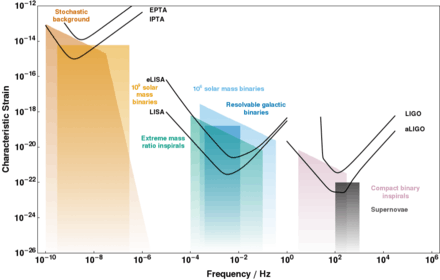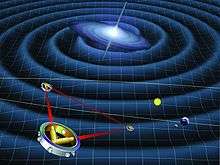Deci-hertz Interferometer Gravitational wave Observatory
| Website | http://tamago.mtk.nao.ac.jp/decigo/index_E.html |
|---|---|
The Deci-Hertz Interferometer Gravitational wave Observatory (or DECIGO) is a proposed Japanese, space-based, gravitational wave observatory.[1][2] The laser interferometric gravitational wave detector is so named because it is to be most sensitive in the frequency band between 0.1 and 10 Hz,[3] filling in the gap between the sensitive bands of LIGO and eLISA. If funding can be found, its designers hope to launch it in 2027.
The design is similar to eLISA, with three zero-drag satellites in a triangular arrangement, but using a smaller separation of only 1000 km.
See also
References
- ↑ Kawamura; et al. (2008). "The Japanese space gravitational wave antenna - DECIGO". J. Phys.: Conf. Ser. 122 (1). Bibcode:2008JPhCS.122a2006K. doi:10.1088/1742-6596/122/1/012006.
- ↑ Kawamura; et al. (30 May 2006). The Japanese space gravitational wave antenna - DECIGO. Gravitational-Wave Advanced Detector Workshop. Elba.
- ↑ Sato; et al. (2009). "DECIGO: The Japanese space gravitational wave antenna" (PDF). J. Phys.: Conf. Ser. 154 (1). Bibcode:2009JPhCS.154a2040S. doi:10.1088/1742-6596/154/1/012040.
This article is issued from Wikipedia - version of the 7/1/2016. The text is available under the Creative Commons Attribution/Share Alike but additional terms may apply for the media files.

